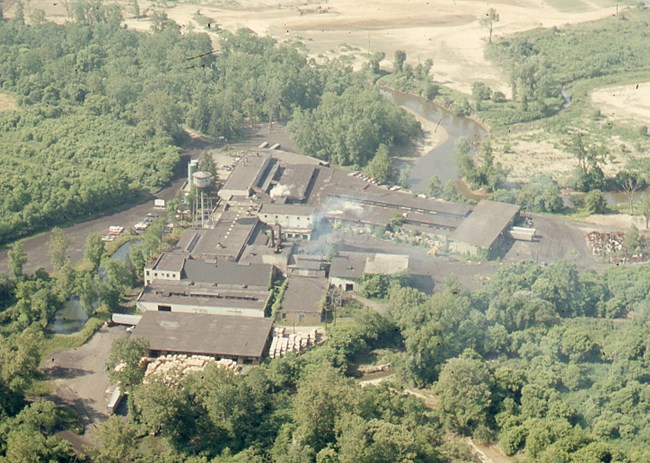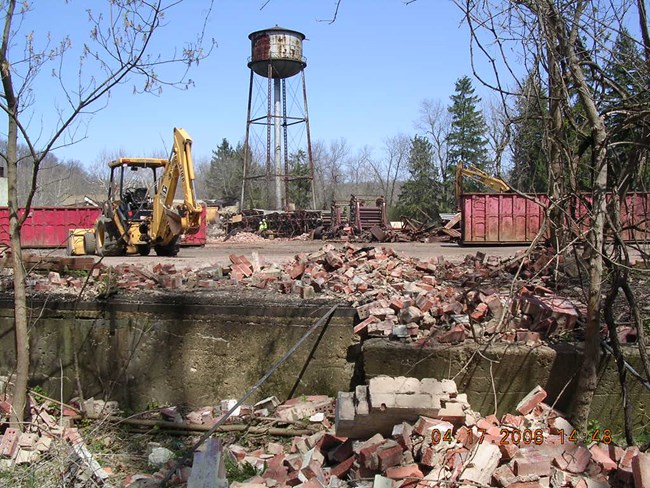Last updated: May 13, 2024
Article
Jaite, a Paper Mill and Company Town

NPS Collection
To many who pass by, the Jaite Mill site is a discarded industrial wasteland, yet for residents of the valley the mill brought work, family, and community together. In 1908, the Jaite Company was considered by William B. Doyle, in his Centennial History of Summit County, “one of the most important business enterprises of this section of Summit County.” Jaite Mill stories of industrialization, community, growth, and decline are a part of the larger story of Cuyahoga Valley National Park.
Charles Jaite
Much of the mill’s early success can be attributed to the quiet, resourceful founder who studied paper manufacturing since boyhood. Charles Jaite was born in Germany, but immigrated to Cleveland with his parents. By age 13, he worked in a paper mill in Cleveland, alongside other immigrants from Germany and Poland. He went on to become the president of Standard Bag and Paper Company in 1902 and vice president of the Cleveland Paper Company. These two firms consolidated to form the Cleveland-Akron Bag Company, located across from present day Boston Mills Ski Resort. In July of 1905, he resigned to begin his own papermaking company.
The Early Mill Years
On September 18, 1905, Charles Jaite founded the Jaite Paper Company with brothers and in-laws as the officers. They purchased 22.76 acres in Northfield Township, deep within the Cuyahoga Valley. They hired local farmers to begin building the mill, using sand dredged from the nearby river to make concrete block. They laid tracks to connect to the railroad and drilled five gas wells and a sixth artesian well that provided water. According to Centennial History of Summit County, the water was of such “purity that the paper manufactured with its use is many points stronger than paper made… with ordinary water.”
The mill site was carefully chosen for its easy access to transportation via the Ohio & Erie Canal and the Cleveland Terminal & Valley Railroad. The site was also close to the water of Brandywine Creek, which later proved unneeded because of artesian wells. Here, halfway between Cleveland and Akron, land was inexpensive and available. The first product Jaite Mill produced was “Blue Line Paper,” used for flour bags and made on a cylinder machine, which creates sheets of paper. Later a second machine was installed that could make paper from rope.
In those first years, after an eight to ten hour day, workers were expected to stay after and mix cement and sand to make more blocks to expand the factory. By 1919, the mill had added another cylinder machine for making single wall bags as the company expanded into fertilizer bags and bread sacks. In 1926, some of the cylinders were rebuilt as two Fourdrinier machines. The Fourdriniers could make continuous long rolls of paper, to be used in making bags with several “walls,” or layers. In 1928 the company produced its first successful multi-walled cement bag. In its heyday during the 1920s and 1930s, Jaite Mill was the 11th largest multi-wall paper producer in the nation.
Heyday Work Force
Although Mr. Jaite began with a small, private operation, his vision for the mill and its workforce was on a much larger scale: not just a company but a community to support the mill as well. In 1906, Mr. Jaite purchased land on Riverview Road, where he built five two-story buildings as employee housing. He added four small single-family units along Vaughn Road in 1917.
A company town developed with homes, a general store, a post office, and a railroad station. A weekly newsletter spread the latest local news. Unlike the stereotypical company town, here there was no script (company-issued money) and people were not forced to live in company quarters. While life was not luxurious, rents were affordable.
By 1918, 214 employees worked at Jaite Mill, and by the Depression years, nearly 250 people were employed. A third of these were women who sewed the bags and worked in the offices. By 1933, during the height of the Depression, the mill operated 24 hours a day. This was its heyday with jobs enough for the local population and for Polish immigrants who moved here to live and work in the mill. A family atmosphere prevailed. In a University of Akron interview, Willy Ritch recalled, “Everybody was related to one another... in the bag plant: father, mother, daughter, son, brothers, sisters.”
At peak production, workers were sleeping in shifts in the dormitory at the intersection of Vaughn and Riverview (now Cuyahoga Valley National Park Headquarters), while others walked or took the company transportation to work from Boston or Peninsula, summoned by the company whistle. The whistle sounded four times per day at set times, creating a rhythm to valley life. When it stopped sounding in the 1950s, it was missed by local residents.

NPS / Ted Toth
The Mill's Later Years
After World War II, the small, private mill was unable to compete with larger mills, particularly those in the south. In 1951 the Jaites made the difficult decision to sell the mill to National Container Corporation. The mill changed hands again, first to Owens-Illinois and then to Tecumseh. One Fourdrinier machine was disassembled, then the bag factory closed, and finally the Jaite Company housing was sold to private individuals.

Akron-Summit County Public Library / John F. Seiberling Collection
The NPS considered many plans for adapting the historic industrial buildings for new uses. Arson on October 2, 1992 snuffed out these plans, leaving the mill a serious safety hazard with unsecured walls and roofs, exposed asbestos, and potential hazardous waste containing chambers.

NPS / Mark VanMouwerik
“It was an enjoyable place to work… away from the hustle and bustle of everything.” - Jerry Cervenski, as quoted in the Cleveland Plain Dealer.
Learn More
Continue exploring Jaite Mill history through historic photos and oral history clips.Visit the mill area by parking at Red Lock Trailhead and following the Towpath Trail south a short distance. The site is marked by an outdoor exhibit with audio recordings of people who once worked there. Please stay out of any fenced areas that have closed to the public during the environmental cleanup.
